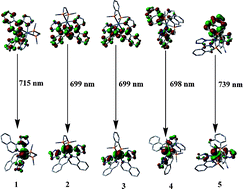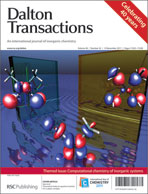DFT/TDDFT Study on the electronic structures and optoelectronic properties of several red-emitting osmium(ii) complexes with different P∧P ancillary ligands†
Abstract
The ground and excited state geometries of several red-emitting phosphors (N∧N)2Os(P∧P) [where N∧N = 5-(1-isoquinolyl)-1,2,4-triazoles, P∧P = bis(dimethylphosphino)methylene(dmpm) (1); P∧P = cis-1,2-bis-(dimethylphosphino)ethene(dmpe) (2); P∧P = 1,2-bis(dimethylphosphino)benzene(dmpb) (3); P∧P = 1,2-bis(dimethylphosphino)naphthalene(dmpn) (4); P∧P = 1,2-bis(dimethylphosphino)-4-cyano-benzene(dmpcb) (5)] have been investigated by using the density functional theory (DFT) methods. The calculated results indicate that, for the studied complexes, the electron-transporting performance is better than the hole-transporting performance. The alteration of cis-P∧P ancillary

- This article is part of the themed collection: Computational chemistry of inorganic systems

 Please wait while we load your content...
Please wait while we load your content...